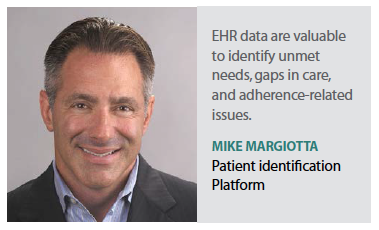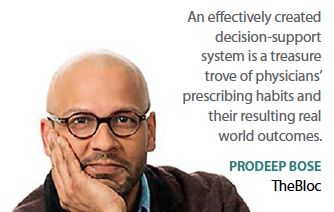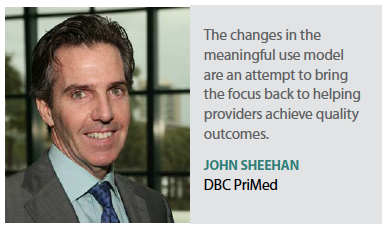In January of this year, the Centers for Medicare & Medicaid Services (CMS) announced its plan to transition from the staged meaningful use program to a new program that would put patients and their outcomes at the center of how it pays for care and supports physicians. The intent is to continue to measure physicians on their meaningful use of certified electronic health record (EHR) technology for purposes of determining Medicare payments, and to provide a significant opportunity to use relevant data collected via EHRs to create better patient-centered clinical decision making.
“Meaningful Use was implemented to drive provider adoption of technology, and to improve the efficiency and quality of healthcare," says John Sheehan, president and chief operating officer, PriMed. “It has certainly increased provider adoption and use of electronic health record systems, but it hasn’t really met its quality mandate."
 Mike Margiotta, CEO and founder, Patient identification Platform (Patient iP), a provider of clinical trial matching technology, agrees that in theory, the MU guidelines made sense, but in clinical practice every single day, they weren’t feasible.
Mike Margiotta, CEO and founder, Patient identification Platform (Patient iP), a provider of clinical trial matching technology, agrees that in theory, the MU guidelines made sense, but in clinical practice every single day, they weren’t feasible.
“There has been some good progress and advances made because of the EMRs being implemented," he says. “But a lot of folks really only got over that first hurdle of being able to get an approved EMR or EHR in the practice. Then they had to get back to caring for patients."
(Editor’s note: EMR vs. EHR. Many within the industry use EMR and EHR interchangeably, however, for the purpose of this article, EMR refers to a patient’s medical history; an EHR is a more comprehensive report of the patient’s overall health, often shared with other providers.)
Mr. Sheehan views the changes in the meaningful use model as an attempt to bring the focus back to helping providers achieve quality outcomes. EHRs are and will continue to evolve to be more problem-oriented medical records, designed to capture information as a doctor treats a patient as a support mechanism and not as a data-entry taskmaster, he adds.
“At the highest levels from CMS, it appears there’s a real interest in helping doctors get back to treating patients and improving patient health," Mr. Sheehan says.
It is important to note that the original initiative may be eliminated in its current form, but the shift will not undo the past advances made. The new CMS proposal looks to enhance factors that were not addressed previously, like EHRs being more of a housekeeping burden than clinical decision-making tool.
The overall goal of MACRA and MIPS (see digital issue for more information) is to better align physician payment with patient outcomes, and this may indirectly drive two measures within the Stage 3 MU guidelines to the forefront — clinical decision support and clinical quality measure reporting — which will add more value to EHRs, not only to physicians and patients, but also to the pharmaceutical industry.
 “The relationship between clinical decision support and clinical quality measure reporting is going to evolve starting now, when collectively, the half a million physicians in the United States will start capturing data that can be mined and pushed back within the EHR to provide a clinical decision support system that is based on the analysis and in near real time," says Prodeep Bose, executive VP, innovation and product development, TheBloc. “The Holy Grail is being able to assess not just clinical trial data on how a drug performs, but how drugs are performing in the real world, with real patients with compliance and adherence issues and across multiple combinations of drugs."
“The relationship between clinical decision support and clinical quality measure reporting is going to evolve starting now, when collectively, the half a million physicians in the United States will start capturing data that can be mined and pushed back within the EHR to provide a clinical decision support system that is based on the analysis and in near real time," says Prodeep Bose, executive VP, innovation and product development, TheBloc. “The Holy Grail is being able to assess not just clinical trial data on how a drug performs, but how drugs are performing in the real world, with real patients with compliance and adherence issues and across multiple combinations of drugs."
The evolution to a more qualitative data collection system will be a total game changer, he says.
“The patterns that emerge in the real world with real outcomes can be very different from outcomes from clinical trials," Mr. Bose says. “This is valuable because we are observing a patient longitudinally over longer periods of time than a typical clinical trial."
Imagine, he says, being able to aggregate outcomes with multiple quality measures across a co-morbid diabetes population over a period of 10 years. Specific population health data of that nature would allow physicians to start making clinical decisions not only on clinical trial data or their personal experience, but on the collective experience across physicians.
“Long-term real-world evidence that has not necessarily been studied within the confines of a clinical trial will start to become visible," Mr. Bose says. “Addressing this information in a scientifically valid manner within both a promotional and a medical context is something that every pharma marketer should be thinking about today."
EHR data give pharma a source of real-world evidence that can help companies make decisions designed to support the ultimate goal of getting the right treatments to the right patients at the right time, says Douglas Taylor, director, health economics and outcomes, Ironwood Pharmaceuticals.
“We use EHR data to support decision-making throughout the lifecycle of our products, from preclinical to post-marketing," he says. “De-identified HIPAA-compliant data on patient and healthcare provider behavior can help us understand if the treatment algorithms and guidelines that we might see in the literature and at advisory boards are followed in the clinic, in both small practices and large centers of excellence. These data might include how often prescriptions are written and refilled and at which dose, how often patients use healthcare services and for which reasons; they also may also contain measurements — labs, vitals, clinical observations. Together, they can give us insight into all phases of an episode of care, from presentation to diagnosis to treatment to outcomes."
Challenges of Managing EHR Data
From an implementation perspective, these data are very large in size and fairly expensive to license. A company needs to decide whether it wants to host and analyze these data in-house or outsource it. According to Mr. Taylor, there are pros and cons to both approaches.
“Going in-house requires a sufficient informational technology infrastructure and analytic capabilities," he says. “Outsourcing removes the infrastructure burden, but still requires sizable budget and oversight."
From an analytical perspective, Mr. Taylor says the biggest challenge is that the EHR industry in the United States is fragmented, with a myriad of different systems that don’t necessarily communicate with one another. So, as patients see physicians in different practices that use different systems, it can be very difficult to get a complete picture of patients’ care, which could bias analysis. Also there may be great variability in how much or how well individual providers enter data into the system, another potential source of bias.
“Also, because EHRs generally don’t provide eligibility data, we can’t confirm with certainty a denominator of total patients within a practice, which can make it difficult to calculate rates of events," he adds.
The lack of intra-operability and the large number of vendors in the space are definite challenges, says Jeremy Brody, executive VP, corporate development, Kantar Health.
“Ultimately, we need intra-operability between the different systems," he says. “We need any system that interacts with patient care to speak to each other so that the best care can be provided to patients by way of physicians having all the available information they need in order to make good clinical decisions."
Mr. Brody expects the future of EHRs will evolve to include greater functionality of platforms, especially patient access and interaction features within the EMR system. He also predicts that consolidation of EHR vendors will occur, shrinking the vast playing field of today.
Gaining Value: Messaging within EHRs
Historically, the pharma industry was thought to be left out of the EHR data space, due to stringent promotional regulations and worries about privacy. However, increased adoption by physicians through meaningful use initiatives has opened up opportunity in two areas: positioning branded and unbranded messaging within the EHR system, and collecting real-world evidence across the patient spectrum for improved clinical support. More and more companies are taking advantage of these opportunities, our experts say.
“With the greater adoption of new technologies by physicians, EHRs have increased in relevance and importance for pharma companies," Mr. Brody says. “The ability to analyze large data sets certainly has contributed to the change as well."
EHRs represent an opportunity for marketers to communicate to a physician throughout a product life cycle — from clinical trial recruitment to workflow interventions, says Angelo Campano, senior manager of engagement strategy, Ogilvy CommonHealth. “The opportunity for marketers in EHRs is here, and physicians want pharma involvement. But it’s imperative that a brand has a clear EHR strategy to capitalize on this channel opportunity and ensure we are providing a fully integrated communications plan."
The industry has been using EMR platforms to facilitate intervention at the point of care. According to Mr. Brody, pharma companies have been setting up various reminders and alerts within the physician workflow in order to guide physicians toward best practices in medicine.
“Most physicians are looking for pertinent alerts to be integrated in their EMR workflow, so pharma has the opportunity to be involved in that in two ways," he says. “One is, of course, supporting the research to be able to identify those best practices in the first place, and second, sponsoring various interventions within the EMR systems themselves that promote those best clinical practices."
These alerts can help physicians improve the care being provided to the patient, but also may encourage increased prescribing and better compliance, and therefore have a positive impact for the pharma companies.
Mr. Campano believes huge opportunities lie in leveraging patient data from physician records to deliver direct messaging to the patient. For example, a promotion or clinical message is delivered to the doctor during the patient interaction to write a specific prescription. When the prescription is written, an alert is generated and secure messages can be sent to that patient through his or her EMR.
“So, we’re not only affecting the doctor interaction, but we’re also affecting patients after they have left the doctor’s office," he says.
 Reachability of patients is actually a lot higher than most people expect, Mr. Campano adds, citing a real-world example of a specialty oncology product that is used by about 40,000 patients.
Reachability of patients is actually a lot higher than most people expect, Mr. Campano adds, citing a real-world example of a specialty oncology product that is used by about 40,000 patients.
“Of the 40,000 patients, we were able to communicate to 20,000 of them through their EMR," he says. “So, we’re able to use that data from the doctor-patient interaction to better speak to our patients to get them better involved with the drug."
There are also several ways to reach physicians through EMRs. One obvious component is providing information about a brand at the point-of-prescribing that is of high clinical value to physicians. Additionally, according to Decision Resources’ study Taking the Pulse, at least 40% of HCPs say patient education, samples, vouchers, patient financial support, and product information are features they are most interested in seeing in EMRs. Other examples include formulary data and safety updates. EMRs can also be used for direct marketing to physicians through banner ads, industry-sponsored clinical resources and emerging solutions.
Marketing to HCPs through EMRs is, however, not without its obstacles, Mr. Campano says. There are about 300-plus EMR system vendors with only a handful offering partnerships with pharma companies. Therefore using EMRs is not a one-size-fits-all approach to marketing, and it might be required to customize materials for each platform. There are also concerns about privacy, interruption of the HCP process by forcing information during a clinical decision, and the intricacies of integration with EMRs.
“There’s a couple ways that we’re delivering specific messages when they’re pinpointed," he says. “One is the traditional banner advertisement, but we make sure that the banner advertisement is meaningful and it’s useful when it’s being delivered. For example, having printable material accessible after clicking on the banner, such as patient education, coupons, sample request forms, things that are of use and meaningful to the doctor-patient interaction."
Gaining Value: Clinical Decision Support
According to Mr. Taylor at Ironwood Pharmaceuticals, there are systems that are able to provide data from more targeted audiences from larger populations.
“There are some really exciting things happening," he says. “Vendors are integrating more EHR systems into their data warehouses, giving us a larger population to analyze. They are also developing better systems to translate physician notes into structured data, which is easier to analyze. Additionally, these vendors are now able to link data to other systems, such as health insurance claims and pharmacy customer loyalty programs, which should help provide an even more complete picture of patient healthcare behaviors."
As with messaging, while there are opportunities to mining EHR data, it is not without its challenges. According to Mr. Margiotta, one of the biggest challenges is gaining access to the data.
“There’s a big difference between having data in an EMR and being able to get that information out of the system and then being able to access and use it in a way that would advance clinical trials," he says.
 However, while security breaches and HIPAA compliance are concerns, the hurdles to secure platforms are diminishing with the advances in technology and process.
However, while security breaches and HIPAA compliance are concerns, the hurdles to secure platforms are diminishing with the advances in technology and process.
“The industry is making significant progress working with medical centers around the country to integrate platforms and access the information in a security-focused manner, with the upmost priority on confidentiality and patient privacy," Mr. Margiotta says.
These types of data could be very valuable to identify unmet needs, gaps that currently exist in care and adherence-related issues.
“That value of EHR data can be seen very early, in helping to identify potential sites for clinical trials or clinical trial design, and certainly in the health economics and outcomes arena," Mr. Brody adds. “It’s a wonderful data source for being able to do HEOR types of research. But in the case of all of these applications, they are dependent on the size, quality, the comprehensiveness of the particular EMR data source with which one is working."
Mr. Sheehan provides examples of how pharma can gain valuable insights from real- world data collected from EHRs.
“We work with two different vaccine manufacturers that use our real-world evidence research platform to identify patients who meet criteria for treatment," he says. “The system flags patients older than 65 years who have certain factors in their medical record, suggesting they should receive a particular vaccine, with automatic alerts presented to the provider at the point of care.
“So, for all the patients that showed up on a particular list, we measure how many were targets for the vaccine and then because we own the electronic health record, we further measure who on that list received the vaccine because the doctor will enter that information in the EHR and that data is reported back to the pharmaceutical manufacturer that supported that service to the provider and to the patient," Mr. Sheehan explains.
The key benefit of using data from EHRs is the longitudinal aspect of being able to follow patients over time.
“Without longitudinal views, we can’t identify what the provider was choosing over time," Mr. Sheehan says. “All we know is that at the end of the year, there were 4,522 scripts written, but we don’t know in what instance those scripts were written. Because we can follow patients month after month, we can see those patterns of care by providers and we can index any variation we see, and those are pretty valuable reports back to our customers."
Another significant benefit that can be derived from EHRs is the impact of CME, Mr. Sheehan says. Non-promotional and continuing medical education activities function the same way as promotional messages within the EHR.
Pharma is able to measure the impact of education that’s consumed across these platforms and receive reports back on provider performance that’s defined as changes in pharmacological intervention rates, as well as quality or clinical measures. These reports show if the provider performance or behavior pattern changed, and if that change impacted the patient.
More Value-Adds
EHR data offer a very powerful look into the way that patients are being treated and the outcomes of that treatment; however; it can also help with post-launch safety monitoring and substantiating the value of a product for reimbursement purposes, Mr. Brody says.
“Pharma companies are increasingly being required by the FDA, EMA, and other regulatory authorities to make sure that their products are being monitored even after they’ve been approved for marketing in a particular country to make sure that there are no safety issues with that product that were not uncovered or discovered during the clinical trial process," he adds.
EMR data can also help pharma companies prove the value of their product to payers by using the data to support the value proposition that they suggest.
Mr. Margiotta believes that when access to EHR data increases for the industry, its reliance on claims data may diminish. Data collected from the EHR can be much more valuable and targeted than prescription or insurance billing data.
“Companies use claims data because that’s really the only thing that’s available, but it has been proven over and over to waste tens of billions of dollars a year in selecting the wrong study sites and developing protocols with criteria that just don’t line up to the actual patient population, because this information can’t be derived from claims data," Mr. Margiotta says. “The whole pharmaceutical industry is shifting away from this approach and looking more toward genome typing and a patient-centric view of the patient, and EMRs are built to be able to have some level of granularity." (PV)


















